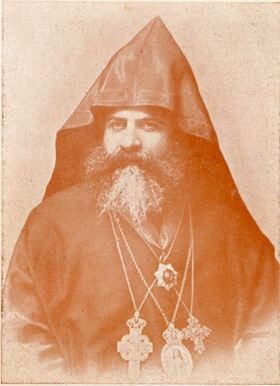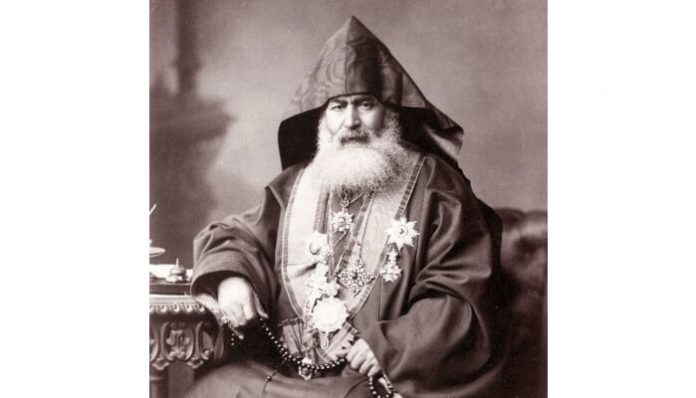Conquest of Britain, Exit of Turkey
December 9, 1917
Fr. ZAVEN ARZOUMANIAN, PhD
Political Scene
During World War I politically unsafe and uncertain situation dominated in Palestine under the Ottoman Turks until 1917 as the St. James Armenian Patriarchate remained vacant. Patriarch Harutyun Vehabedian had died in 1910, and in 1916 the Turkish authorities declared the ousted Catholicos Sahag II Khabayan of Cilicia “Patriarch-Catholicos” to reside in Jerusalem as an exiled pontiff, thus eliminating both, Sis his headquarters, as well as Patriarch Zaven Der Yeghiayan and the Armenian Patriarchate of Constantinople. The ruling was entirely cruel, illegal and against the canons of the Armenian Church.
Having no choice Catholicos Khabayan consented with the orders given, along with a ridiculous Turkish bylaws dictated by the Turkish government and imposed on him. The Catholicos remained in Jerusalem only 15 months, while Patriarch Zaven was exiled to his native Iraq. Soon the British army occupied Palestine and expelled the Turks, as the Armenian clergy were forced to leave by the Ottomans just before the British army sacked the Holy Land. Patriarch Zaven returned to his patriarchal office three years later as the British army occupied Baghdad. His patriarchal tenure ended in 1922, from 1914 including the three years of interruption.
While the political scene was upside down and unstable, the St. James Armenian Patriarchate was left unattended with only a couple of resident bishops, Mkrtich Aghavnouny and Yeghishe Chilingirian remaining. Mesrob Vartabed Neshanian was the single faithful member of the Patriarchate who stood firm from way back before the turn of the century to preserve the status quo of the Patriarchate internationally. The British army invaded as we read from Mesrob Neshanian’s documented diary, as to when and what had happened between Turkey and the victorious Great Britain. His description of events is most original, reliable and the only one reached us as an accurate chronology.
Bishop Neshanian was successively elected Grand Sacristan in 1922, Locum Tenens twice in 1930 and 1939, and finally Patriarch of Jerusalem in 1939. He passed away in 1944.
The Invasion of Great Britain
Eyewitness’ “Diary 1917”
Bishop Mesrob Neshanian wrote his valuable “Diary 1917” as an eyewitness on the conflict between the Turks and the British when the Turks were chased out of Palestine. He wrote how on Saturday November 24, 1917, the bishops and a few leading members of the Brotherhood were taken to the police station, following the orders of the Ottoman Turks, including Catholicos Sahag II Khabayan. Father Mesrob Neshanian had accompanied them, stating that “the same evening they were taken to Damascus in three wagons” before he had returned back to the Patriarchate.
Neshanian further described the fight on Sunday the next day between the British and Turkish armies which lasted 6 days. The Ottomans, well organized, had placed tanks around the Russian monastery. They were successful to chase back the British army taking 11 hostages, but suffering 1200 and more casualties with many more injured. On December 3, Father Mesrob Neshanian was called by the Turks to appear in the municipality and was told they needed help with clothing and blankets as a contribution from the Armenian Patriarchate. He did his share and satisfied them.
As an eyewitness Neshanian entered in his “Diary” that the British had the upper hand. In the early morning of December 8-9, they captured Ain Kerim as he was watching from the roof of the Patriarchate the pouring of bombs so fiercely, like “hellish fire pouring down by the British coming from the top of Nebi Samuel.” On Sunday, December 9, 1917, he wrote: “today 400 years’ tyranny ended on the Holy City. No more Turks around, but only British kind people, generals and soldiers, who brought freedom to the Holy Land”.
Patriarch Yeghishe Tourian (1921-1930)

There was no Patriarch in Jerusalem for more than a decade until the election of the venerable former Patriarch of Constantinople Archbishop Yeghishe Tourian in 1921. There was however the problem of the electoral procedure of the candidate since the Patriarchs of Jerusalem were elected by the National Assembly of the Armenian Patriarchate of Constantinople in Istanbul. Politically the British authorities rejected such interference having Patriarch under their mandate elected in Turkey. A fast move was necessary and a request was submitted to the British authorities to have the election as before “just for the last time only”. Permission was granted, election in Constantinople took place, and the new Patriarch Yeghishe Tourian arrived in Jerusalem. New bylaws drafted in the interim and the next Patriarch was elected by the members of the Brothehood exclusively.
Under Patriarch Tourian
The Patriarchate needed bishops urgently, and three candidates, headed by Mesrob Vartabed Neshanian were recomended by Patriarch Tourian to travel to Holy Etchmiadzin to receive episcopal ordination: Mesrob Neshanian, Matteos Kayekjian, and Smbat Kazazian were ordained by His Holiness Kevork V Catholicos of All Armenians in September 1924. Soon two important institutions were built, the Tarkmanchats Elementary School and the Gulbenkian Library under the shades of the St. James Cathedral. Hundreds of children attended and graduated from the school with a wealth of knowledge as of today with limited numbers, and the elegant Library remains the house of thousands of books unmatched outside motherland.

